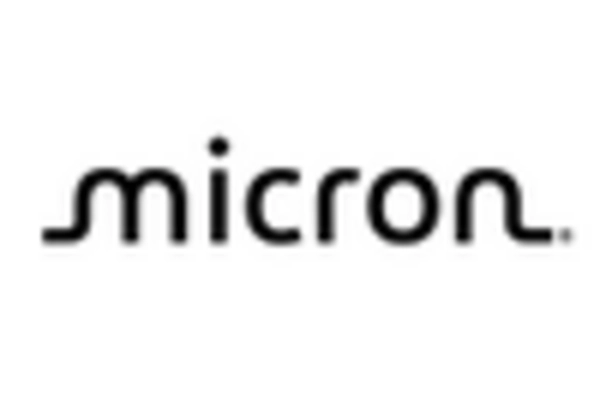Rising Semiconductor Demand
The silicon wafers market in Europe experiences a notable surge in demand driven by the increasing need for semiconductors across various sectors. The automotive industry, specifically, is witnessing a transformation with the rise of electric vehicles (EVs) and advanced driver-assistance systems (ADAS). This shift is projected to elevate semiconductor consumption, thereby enhancing the silicon wafers market. In 2025, the semiconductor market in Europe is expected to reach approximately €50 billion, indicating a robust growth trajectory. Furthermore, the proliferation of consumer electronics and IoT devices contributes to this demand, as these technologies require high-performance silicon wafers for efficient operation. As a result, manufacturers are likely to invest in expanding production capacities to meet the escalating requirements of the semiconductor industry.
Government Initiatives and Support
Government initiatives in Europe play a crucial role in bolstering the silicon wafers market. Various countries are implementing policies aimed at enhancing semiconductor manufacturing capabilities, which directly impacts the silicon wafers market. For instance, the European Union has proposed substantial funding to support the semiconductor industry, with an investment target of €43 billion by 2030. This financial backing is expected to stimulate research and development, fostering innovation in wafer production technologies. Additionally, initiatives promoting local manufacturing are likely to reduce dependency on imports, thereby strengthening the regional supply chain. Such government support not only encourages investment in advanced manufacturing facilities but also enhances the competitiveness of the silicon wafers market in Europe.
Emerging Applications in Electronics
The emergence of new applications in the electronics sector is driving growth in the silicon wafers market in Europe. Technologies such as 5G, artificial intelligence (AI), and machine learning are creating a demand for high-performance silicon wafers that can support advanced functionalities. The integration of silicon wafers in these applications is expected to increase, as they are essential for the development of faster and more efficient electronic devices. By 2025, the market for silicon wafers used in 5G technology alone is projected to reach €10 billion, highlighting the potential for growth in this segment. As manufacturers adapt to these emerging trends, the silicon wafers market is likely to expand, driven by the need for innovative solutions in the electronics landscape.
Sustainability and Environmental Regulations
The silicon wafers market in Europe is increasingly influenced by sustainability and environmental regulations. Stricter regulations regarding waste management and energy consumption are prompting manufacturers to adopt eco-friendly practices in wafer production. This shift towards sustainability is not only a response to regulatory pressures but also aligns with the growing consumer demand for environmentally responsible products. In 2025, it is estimated that around 30% of silicon wafer manufacturers in Europe will implement sustainable production methods, which could enhance their market competitiveness. Furthermore, the adoption of renewable energy sources in manufacturing processes is likely to reduce carbon footprints, thereby appealing to environmentally conscious consumers and businesses alike. This trend may lead to a more sustainable silicon wafers market in Europe.
Advancements in Wafer Fabrication Technologies
Innovations in wafer fabrication technologies are significantly influencing the silicon wafers market in Europe. The introduction of advanced techniques, such as atomic layer deposition and chemical vapor deposition, enhances the quality and efficiency of silicon wafers. These advancements enable manufacturers to produce wafers with improved electrical properties and reduced defects, which are essential for high-performance applications. As of 2025, the market for advanced wafer fabrication technologies is projected to grow at a CAGR of around 8%, reflecting the increasing emphasis on quality and performance in semiconductor manufacturing. Consequently, the silicon wafers market is likely to benefit from these technological improvements, as they facilitate the production of wafers that meet the stringent requirements of modern electronic devices.














Leave a Comment